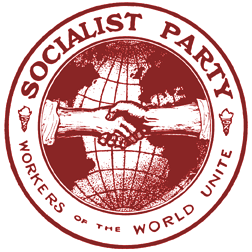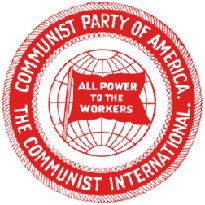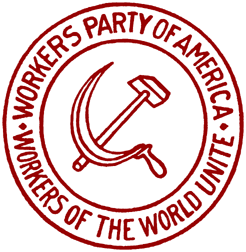

POLISH FEDERATIONS Early Polish Radical Movement in America
Emigré intellectuals from Poland established the first Polish socialist societies in the mid-1880s, according to one historian of the subject. These individuals also formed several Polish branches of the Socialist Labor Party.
[fn: Mary Cygan, "Polish Americans" in Buhle et al. (eds.), Encyclopedia of the American Left, First Edition, pg. 584.]

Alliance of Polish Socialists (ZSP)
The Alliance of Polish Socialists (Zwiazek Socjalisów Polskich, or ZSP) was the first Polish socialist organization in the United States, founded in late-1890s as a group intent on teaching and organizing among Polish emigres in preparation for revolution in Poland. The group retained ties to the Polish Socialist Party [PPS] in the old country and oriented itselves towards the struggle for Polish independence rather than the struggle of the Polish workers for socialism in America. The ZSP published a daily newspaper in Chicago called Rabotnik Polski [The Polish Worker], established in 1896. Later the ZSP additionally published an anti-clerical satirical weekly called Bicz Bozy [God's Whip].
[fn: Executive Committee of the Polish Alliance SP, " The Polish Socialists" in The American Labor Year-Book, 1916. (NY: Rand School Press, 1916), pg. 141; Correspondence with Don Binkowski, Feb. 2005.] A 1910 list of the ZPS's publications included the following, published at 229 -- 6th Street in New York by Wydawnictwa Zwiazku Socyalistów Polskich:
Worek Judaszów: Czyli rzecz o klerykalismie, by Franciszek Mlot. (Illustrated) -- (paper, 25 cents) anti-clerical
Tajemnice klasztoru na Jasnej Górze. (illustrated) -- (paper, 10 cents)
Z tajemnic przyrody. -- (paper, 10 cents)
Pamiatka z misyi socyalistycznej. -- (pamphlet, 2 cents)
Pogadanka o socyalizmie. -- (pamphlet, 2 cents)
Bacznosc! Socyalisci ida! -- (pamphlet, 5 cents)
Czy socyalisci jedza w poscie kielbase? -- (pamphlet, 5 cents)
Precz z socyalistami! -- (pamphlet, 5 cents)
Z robotników slynni wynalazcy. -- (pamphlet, 5 cents)
Kartki z fotografia ks. Macocha i Krzyzhanowskiej, serya 5 sztuk. -- (paper, 15 cents)
By 1912, the Polish Alliance was the smaller of the two affiliates of the American Socialist Party. The group's Translator-Secretary, L. Banka, claimed 97 branches at the end of the first quarter of 1912, including 4 in Canada. The group averaged about 450 dues stamps sold during the first three months of 1912 -- a number which did not necessarily reflect the true size of the organization since a quarter of its branches were in New York and New Jersey, where dues stamps had to be purchased directly from regular party locals.
[fn: L. Banka, "Report of the Polish Alliance" in Proceedings: National Convention of the Socialist Party, pg. 242.] Polish Section of the Socialist Party (ZPPS)
In December of 1908, the Polish socialist movement split, with the minority backing Józef Pilsudski's faction of the PPS, oriented towards secret paramilitary organization and terrorist action against Tsarist authority. The majoirty group, favoring popular education and labor activism, formed the "Polish Section of the Socialist Party" (Zwiazek Polskiej Partii Socjalistyczne, or ZPPS). Both organizations continued to pay extremely close attention to the national liberation movement in the old country, as opposed to single-minded dedication to the struggle of the working class for socialist liberation in America. When first established, the ZPPS had 23 branches and about 400 members.
It was not until April 1911 that the Polish Translator-Secretary's office was established. The 27-year old Hipolit Gluski was the first individual to fill the Polish Translator-Secretary's position. By the end of 1911, the Polish Section was an organization of 115 branches with a membership of 1,450 in good standing, with another 680 members on the books but financially in arrears. The first quarter of 1912 saw a net increase of 15 more branches (to a total of 130), with the paid membership of the Polish Section approaching the 2,000 mark.
The official organ of the ZPPS was a newspaper published in its Chicago headquarters called Dzienik Ludowy [The People's Daily].
[fn: H. Gluski, "Report of the Polish Section" in Proceedings: National Convention of the Socialist Party, pp. 241-242; Correspondence with Don Binkowski, Feb. 2005.] The Polish Section of the Socialist Party emphasized mass education and participation in the labor movement. The group operated a People's University and dispatched activists to organize amongst the Polish workers in the Pennsylvania coal region and textile mills of New England.
[fn: Mary Cygan, "Polish Americans" in Buhle et al. (eds.), Encyclopedia of the American Left, First Edition, pg. 584.]
Polish Alliance of the Socialist Party of America (Polish Federation)
In February of 1913, the Polish Section of the Socialist Party (ZPPS) and the Polish Alliance (ZSP) united to form the Polish Alliance of the Socialist Party, also known as the Polish Federation.
In the Summer of 1916, there was a split in the Polish Federation over the Socialist Party of America's militant opposition to the European war. Many Polish emigres were in favor of the allied war effort as a vehicle to help achieve Polish national independence. The Polish Federation as a whole voted to disaffiliate with the Socialist Party -- a decision which was reversed by the independent action of a substantial number of branches, who voted to retain organizational affiliation. These SPA loyalists reaffiliated with the party as a new Polish Federation. The group reaffiliating claimed a membership of 800 at the time of its reapplication for membership in September 1916.
[fn: Letter of Adolph Germer to Fred Walchli of Bellaire, OH, Sept. 20, 1916. Digital copy in Tim Davenport collection.] The "new" Polish Federation of the Socialist Party was dominated by radicals taking their lead from Rosa Luxemburg's Social Democracy of the Kingdom of Poland and Lithuania (SDKPiL), an anti-nationalist and anti-militarist organization.
[fn: Mary Cygan, "Polish Americans" in Buhle et al. (eds.), Encyclopedia of the American Left, First Edition, pg. 585.] The group -- although much smaller than the earlier Polish Federation -- was positioned on the ideological left of the SPA and transitioned seamlessly into the Communist movement after the party split of 1919.

Polish Federation of the Communist Party of America
Translator-Secretary for the SPA's Polish Federation in 1919 was Joseph Kowalsky. He was a delegate to the Founding Convention of the Communist Party of America.
Executive Secretary of the Polish Federation of the CPA in mid-1921 was "G. Kruk."
In late 1921, during the 5 months between formation of the unified CPA and the split of the Central Caucus faction, the Communist Party's Polish Federation had an average monthly paid membership of 242, making it the 8th largest of the 10 Language groups in the party.
[fn: Comintern Archive: f. 515, op. 1, d. 75, l. 12.] Polish groups in the United Communist Party of America
There was a Polish Secion of the UCP. The Executive Committee of the Polish section were based in Pittsburh, PA.
There were a total of 34 of the UCP's 673 primary party units ("Groups") in December of 1920 that spoke Polish. Some 13 of these were located in the Cleveland districts, with 7 more in Chicago and 6 in New York City.
[fn: DoJ/BoI Investigative Files, NARA M-1085, reel 940, doc. 501 -- downloadable below.]

Polish Language Section of the Workers Party of America
The First Convention of the Polish Federation of the WPA was held on Feb. 4-5. The gathering adopted the constitution of the WPA and elected a 10 member Federation Executive Committee, consisting ot:
S. Nowakowski (Secretary); W.M. Tabenski (Editor); C. Brudzynski (Organizer); J. Kaminski, J. Kopaszynski, F. Kraswoski, T. Mlynek, J. Podkulski, A. Szostak, and B. Szymanski.
The Polish Language Section maintained its headquarters at 1041 Milwaukee Ave., Chicago.
The 1924 convention of the Polish Federation of the Workers Party was attended by delegates representing 31 branches in 18 cities in the East and Midwest. Chairman of the convention was Boleslaw Gebert, former editor of the Federation's organ, Glos Rabotnitczy. A report of the Central Executive Committee was delivered by Earl Browder.
"Report of Committee on Foreign Speaking Organizations to the National Convention of the Socialist Party, May 17, 1908." Committee report to the 1908 SPA Convention in Chicago, delivered by S.A. Knopfnagel. The Committee advocated the acceptance of all foreign language organizations seeking affiliation with the Socialist Party, subject to 5 conditions: "(1) They are composed of Socialist Party members only. (2) Any foreign speaking organization having a national form of organization of its own be recognized only if all the branches composing this organization having been chartered by the national, state, or local Socialist Party organizations, and pay their dues to the respective Socialist Party organizations. (3) No foreign speaking organization asking the Socialist Party for recognition shall issue their own particular national, state, or local charters. Same to be issued only by the respective organizations of the Socialist Party, as the case may require. (4) All foreign speaking organizations affiliated with the Socialist Party must and shall conform in every respect with the Socialist Party national, state, and local constitutions, platforms, and resolutions. (5) They should function only as agitation, education, and organization bureaus of the Socialist Party." Includes an amendment made from the floor but not published in the SP's Official Bulletin (probably due to incompetence rather than malice) prohibiting the refusal of admission to the SPA on account of race or language.
Report of Polish Section to the Socialist Party National Convention, May 1912," by H. Gluski. Until the groups unified in February 1913, there were two Polish-language affiliates of the Socialist Party of America. This is the report of Translator-Secretary of the larger of these two groups, the Polish Section of the Socialist Party (Zwiazek Polskiej Partii Socjalistyczne -- ZPPS), to the 1912 Indianapolis National Convention of the SPA. A few details about organizational history, size, and the Polish-language press are provided in this very short document.
Report of the Polish Alliance to the Socialist Party National Convention, May 1912," by L. Banka. Until the groups unified in February 1913, there were two Polish-language affiliates of the Socialist Party of America. This is the report of Translator-Secretary of the older-but-smaller of these two groups, the Alliance of Polish Socialists in America (ZSP), to the 1912 Indianapolis National Convention of the SPA. A few details about location of party branches of the Polish Alliance and the group's dues stamp sales in the first quarter of 1912 are provided in this very short document.
"Scuttling the Ship: A Statement of the Seven Suspended Language Federations, June 2, 1919." This is the joint protest statement of the 7 affected Language Federations of the SPA (Russian, Lithuanian, Ukrainian, Polish, Hungarian, South Slavic, and Latvian) in response to the May 27 action of the party's National Executive Committee to unilaterally suspend the entire memberships of these organizations. The "autocratic 7" members of the National Executive Committee who approved this action on "over 30,000 dues payers" are rebuked for failing to provide notification, time for preparation, or a trial. In addition, the NEC bloc of 7 suspended the party elections and expelled the Michigan organization of nearly 6,000 without trial, locked up the party headquarters in the hands of a private holding company outside of party control, and arbitrarily threw the Translator-Secretaries of the affected federations out of party headquarters without allowing time for them to locate new quarters. "In short, this group of seven National Committeemen, drunk with power they assumed, feeling aggrieved because these federations dared to criticize the National Executive Committee, made themselves guilty of an act which will discredit them forever in the International Socialist movement," the joint statement charged.
United Communist Party -- "Groups" According to Language: As of December 1920." This is based upon an internal document of the United Communist Party captured by the Department of Justice's Bureau of Investigation in the April 1921 raid on UCP National Headquarters in New York. The UCP prided itself on having largely eliminated the federation-based form of organization which typified its rival, the Communist Party of America. Groups (Primary Party Units of between 5 and 10 members) were nevertheless based around language as well as geography and statistics tabulated by the organization. This snapshot from the midpoint of the UCP's one year of existence surprisingly shows more South Slavic (Croatian and Slovenian) language groups than any other (144), followed by the Russian (136), English (121), German (61), Latvian (49), Yiddish (37), Lithuanian (34), and Finnish (31) language groups.
MAY CPA Condensed Cash Statement, Feb. to May 1921, Including Federations, But Not Including Payments to and from the National Office and the Federations: Presented to the Joint Unity Convention, Woodstock, NY - May 15, 1921." This is a very esoteric budget document, but specialists in the history of the early American Communist movement will probably immediately recognize its import. For me, at least, this document has led to a fundamental rethinking about the nature of the old CPA, for it shows that the organization truly was a "federation of federations." Five of the old CPA's 6 Language Federations possessed assets at least twice the size of the National Office of the organization. The same 5 possessed printing plant in excess of the National Office. Three of them retained substantial real estate holdings. Three of them spent more money than the National Office on literature production, and a fourth spent approximately the same amount as the National Office. These were clearly fully functioning political organizations in their own right, not tiny social groups of members speaking a common language. It is little wonder that the "Federation Issue" stood so large on the landscape as the primary issue impeding merger efforts between the UCP and the old CPA for so long and fueling the Central Caucus split that erupted in late November of 1921.
"Membership Series by Language Federation for the Workers Party of America. 'Dues Actually Paid' -- January to December 1923." Official 1923 data set of the Workers Party of America, compiled from a document in the Comintern Archive. This series shows a great numerical dominance of the WPA by its Finnish Federation, accounting for a massive 42.8% of the average monthly paid membership of the organization (6,583 of 15,395). The total of the English language branches is the 2nd strongest amongst the federations (7.6%) followed by the South Slavic (7.5%), Jewish [Yiddish language] (6.9%), and Lithuanian (6.0%) Federations. In all, there were statistics kept for 18 different language groups of the WPA in 1923, including the English and the barely organized Armenian sections.
"Initiation Stamps Sold by Federation for the Workers Party of America. January to December 1923." Official 1923 data set of the Workers Party of America, compiled from a document in the Comintern Archive. This series once again (repeating the previous published 1924 series) shows a schizophrenic pattern of stamp sales among language groups . Some federations clearly did not collect the initiation fees called for in the WPA constitution at all (Jewish, German, Latvian) while at the same time the quantities sold via the English branches are ridiculously high. Over 53% of the initiation stamps sold for the entire WPA were credited to the English branches -- nearly three times as many initiations than there were average duespayers in those English branches! Even assuming a significantly higher than average "membership churn" rate for English branches, there is clearly some other unexplained phenomenon at play in these English branch initiation stamp sale figures...
"Membership Series by Language Federation for the Workers Party of America. 'Dues Actually Paid' -- January to December 1924." Official 1924 data set of the Workers Party of America, compiled from a document in the Comintern Archive. This shows a continued numerical dominance of the Workers Party of America by its Finnish-language federation, averaging a paid membership of 7100 (41% of the entire organization) for the year 1924. Impressive growth is shown by the Yiddish-language ("Jewish") federation, which moved to the third largest language group in the WPA in 1924. The English branches comprised the second largest language group in the WPA, but still remained just 11% of the overall organization. The South Slavic federation (predominately Slovenian and Croation) was the 4th largest language group in the WPA, topping the Russian, Lithuanian, and Ukrainian federations.
"Initiation Stamps Sold by Federation for the Workers Party of America. January to December 1924." Official 1924 data set of the Workers Party of America, compiled from a document in the Comintern Archive. An extremely interesting monthly series in which two unexplained anomalies are apparent: (1) The failure of at least 8 of the WPA's 18 language sections to make more than a token effort to collect the $1 initiation fee and obvious similar behavior (to lesser degree) among branches of other language groups; (2) A preposterously large sale of 5,264 initiation stamps to "English" branches, which averaged a paid membership of just 1909 over the course of the year. Either there was a revolving door in the English branches that was entirely dissimilar to the situation in any other language group of the WPA; or there was some sort of effort to collect initiation fees among "English" workers without organizational follow up; or there was some sort of strange accounting practice used by the WPA in which miscellaneous sales of initiation stamps were lumped into the "English" category (or some combination of these explanations). A perplexing question in raised, with further archival research clearly necessary.